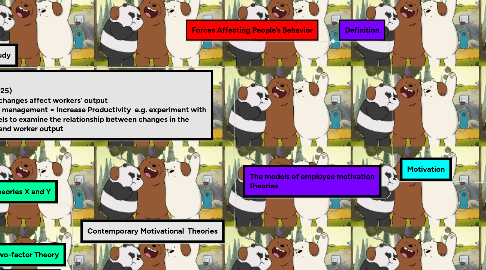
1. Motivation
1.1. Definition
1.1.1. Forces Affecting People’s Behavior
1.2. The models of employee motivation theories
1.2.1. Classical Theory Frederick Taylor (1911) More Money = Greater Motivation Efficient Company = Higher Profits & Pay Time-And-Motion Study
1.2.2. Behavior Theory Hawthorne studies (1925) Physical environment changes affect workers’ output Special attention from management = Increase Productivity e.g. experiment with increasing lighting levels to examine the relationship between changes in the physical environment and worker output
1.2.3. Contemporary Motivational Theories
1.2.3.1. Human Resources Model: Theories X and Y
1.2.3.1.1. Theory X – theory of motivation holding that people are naturally irresponsible & un cooperative
1.2.3.1.2. Theory Y – theory of motivation holding that people are naturally responsible, self-motivated, and interested in being productive
1.2.3.2. Two-factor Theory
1.2.3.3. Maslow’s Hierarchy of Needs Model
1.2.3.4. Expectancy Theory
2. Controlling
2.1. Definition
2.1.1. Schermerhorn : Process of measuring performance and taking action to ensure desired result
2.1.2. Beach : Controlling is a systematic exercise , which is called as a checking actual performance against the standards or plans . This process is to adequate progress and also recording such process for possible future needs .
2.2. Importance
2.2.1. 1. It facilitates co-ordination
2.2.1.1. control systems provide managers with information and feedback on employee performance
2.2.2. 2. It helps in planning
2.2.2.1. Control let managers know whether their goals and plans are on target and what future actions to take
2.2.2.2. The planning-controlling Link
2.2.2.2.1. feedback control
2.2.3. 3. Protecting the workplace
2.2.3.1. Control enhance physical security and help minimize workplace disruptions
2.3. Controlling process
2.3.1. step 1 : establish performance objectives and standards
2.3.2. step 2 : measure actual performance
2.3.3. step 3 : compare actual performance with objectives and standards
2.3.4. step 4 : take necessary action
2.4. Types of controlling
2.4.1. feedforward controls
2.4.2. concurrent controls
3. Leadership
3.1. Psychological contracts in the workplace
3.1.1. Employee’s Contributions
3.1.2. Organization’s Inducements
3.1.3. Human Relations
3.1.3.1. Job Satisfaction/Morale/Turnover
3.1.3.1.1. Strategies for Enhancing Job Satisfaction and Morale
3.1.3.2. Organizational Success
3.2. Theories of employee motivation
3.3. Job satisfaction and employee motivation
3.4. 21st Century Leadership/Management
3.4.1. Motivation
3.4.1.1. Money no longer prime
3.4.1.2. Different desires at work
3.4.1.3. Varying lifestyles reflect varying goals of employees
3.4.2. Leadership
3.4.2.1. Flatter organizations = Less autocratic
3.4.2.2. Diversity of workplace = diversity of leaders
3.4.2.3. Network mentality
